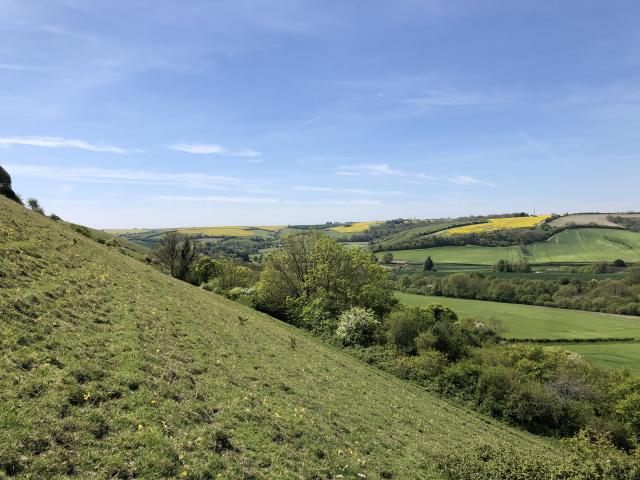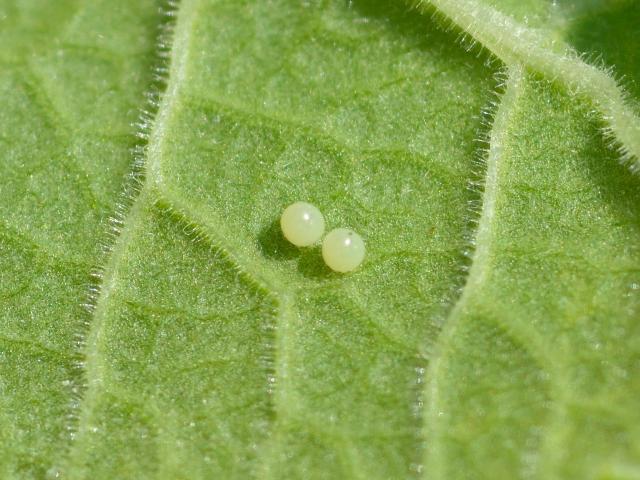Judging on behaviour alone it could be argued that the Duke of Burgundy doesn’t really deserve its aristocratic title.
For despite its diminutive size, the Duke is something of a bar-room brawler, prone to outbursts of violence and lacking in the airs and graces its grand name would suggest.
I’d travelled to Giant’s Hill, a well-known Duke ‘manor’ in Dorset, hoping for an audience with his grace. Daubed yellow with thick smears of Cowslip, the air on the steep, chalk hillside hung heavy with the unsettling aroma of Hawthorn blossom. The hum of countless bees broken only by the occasional jangling of a Yellowhammer.
But initial impressions were misleading. This was no bucolic paradise but an arena for battle. My first sighting of the Duke was a bit, well, disappointing. Perched upon dried dung, the butterfly resembled a value-brand fritillary - a slight concession to orange and black wing markings but mostly dark, with a hint of the squat, functional solidness of a skipper.
But the Duke is all about movement – not good looks. A hapless fly was the first victim, trundling innocently by only to be swooped at, dive-bombed and discombobulated by the enraged butterfly.
Further down the hill there was yet more ungentlemanly behaviour. This time a Small Tortoiseshell was seen off, the vanessid seemingly too obsessed with its own beauty to notice the small ball of Dukey fury hurtling in its direction over the briars to defend its territory.
But despite the unruly behaviour – the presence of this pint-sized pugilist in good numbers is something to celebrate. Barely 15 years ago the Duke was in serious trouble. Decades of decline had seen the butterfly slip toward the trapdoor of extinction. Yet fast forward to today and the butterfly has miraculously fought back. The latest butterfly statistics revealed that the Dukes’ population is now stable and in some places, it is thriving.

So what is behind the turnaround? Dr Dan Hoare, Butterfly Conservation’s (BC) Director of Conservation explained that the first step was to find out how many colonies of the butterfly were left and what state where they in. Painstaking searches revealed that more than half of the 160 colonies left were tiny with less than 10 adults on the wing at peak, making them barely viable and only 12 sites classed as large (with more than 30 flying at peak).
Studies by BC and partners found that over-grazing, habitat destruction and a reduction in coppicing were all factors in causing the butterfly’s seemingly terminal decline, all issues that are avoidable with the right type of land management.
Dan explained: “Armed with the knowledge of where the remaining colonies were, where the most important populations were in each landscape, we set about improving habitat condition for the species on hundreds of sites across its range, by providing specific advice to landowners about what the Duke needs, where it was breeding on their land and how to accommodate its fussy needs.
“BC’s landscape-scale conservation works through three steps: improve management of the big populations already occupied at the heart of the landscape; enhance nearby sites with small populations through targeted habitat management to increase the population; and restore former sites where the Duke had gone extinct, potential sites where it’s never been recorded and improve connections between sites so the species can move around and recolonise.”
Key to the Duke setting up a happy grassland home is the Cowslip (Primroses are used in woodland habitats). Seen close up, this springtime siren resembles a traffic light as if imagined by Salvador Dali – the offspring of a multi-headed fire-hydrant that has been intimate with a Triffid.

But these beguiling looks are irresistible to broody Dukes, but they don’t just lay eggs on any old Cowslip – those chosen tend to be on more sheltered north-facing slopes, ideally large flowering plants with wide leaves that are half shaded by a nearby shrub or tussock.
The Duke is now recolonising and thriving in Kent, Sussex and the North York Moors and is also making good progress in the Cotswolds, Wiltshire and the Chilterns, but as Dan explains, the battle for the butterflies’ future is not yet won.
He said: “There is still much to be done to secure the Duke’s status and ensure it thrives across its range. Monitoring its numbers allows us to provide feedback when land management is not working, or decide priorities for future work. We were too late to save the Duke in the Isle of Wight, where it’s now extinct, and it is critical in Somerset, Lincolnshire and other areas. We must sustain our efforts and continue to build the broad partnerships needed to save this and other species.”
So despite the brawler’s seeming belligerence, the Duke is still a butterfly under threat. A gentleman he is not, but a survivor? Certainly.
Liam Creedon is editor of Butterfly magazine. Follow Liam on twitter @liamcreedon
You can spot the Duke of Burgundy at BC’s Prestbury Hill reserve near Cheltenham, Gloucestershire.


